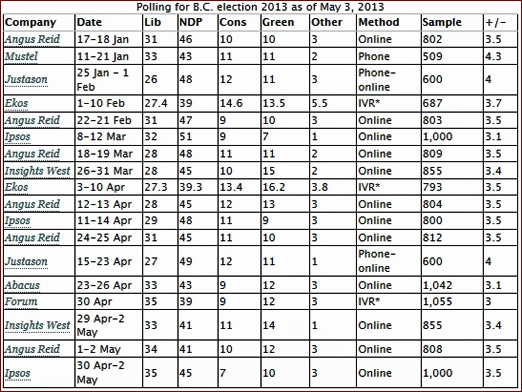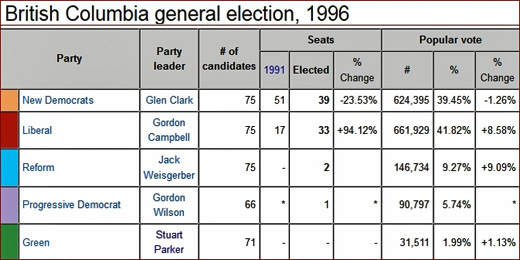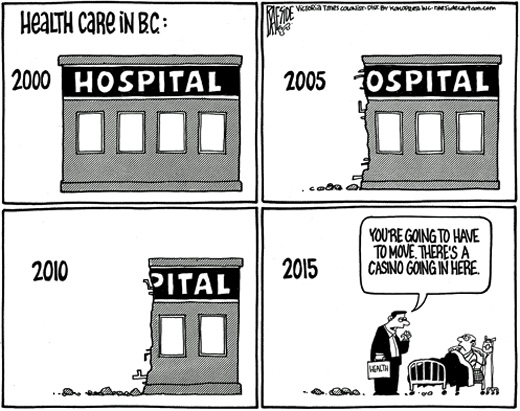
Part Two: Don’t Allow Decision BC 2013 Polls to Get You in a Tizzy
Have another look at the BC Election polls above, and the more detailed analysis we published on the weekend, and the following series of questions arise, “How do the poll results relate to the probable outcome of the British Columbia provincial election, how many seats is each provincial party likely to garner on election night, which ridings are in contention that will tip the election result one way or another and, finally, what does it all mean for British Columbia going forward into the future, most particularly between May 14, 2013 and the next provincial election, in the autumn of 2017?”
A few of the questions above were answered in VanRamblings’ weekend post. We’ll address the remaining questions in postings we’ll publish over the course of the final week of the Decision BC 2013 election campaign. Stay tuned, cuz this is going to be one humdinger of a provincial election.
Know this: the BC New Democrats and the BC Liberals are running disciplined campaigns. Both campaigns will stay on message, and both Adrian Dix and Christy Clark will continue to hammer home the main themes their parties are promoting to voters (change vs more of the same).
In the final week of Decision BC 2013, neither of the main contending parties for government will move anywhere close to going off track, although there’s a greater likelihood you’ll see the NDP mounting an edgier campaign in the next seven days, as Adrian Dix raises issues involving the BC Liberals’ sorry record of governance — of which example there are many — the Liberals’ 12-year history of fiscal mismanagement, as well as their abject failure to govern in the interests of a majority of British Columbians.
Let’s face it: there was never any question that the British Columbia election campaign would not tighten up closer to election day, May 14th. Not for nothing has VanRamblings consistently predicted 54 seats for the BC NDP in the legislature for the coming term of office, and somewhere around 26 – 30 seats for the BC Liberals. In the polarized political climate of British Columbia, we in this province have a history of only 3 per cent, or less, of the provincial vote separating the two main parties on election day.
The difference this time? As we say above, in 2013 the advantage goes to the BC New Democrats. The best the BC Liberals can hope for in 2013 is a decent showing at the polls on election night (30+ seats would be considered a massive win for this discredited party), leaving the BC NDP left only to ponder the size of their majority in the British Columbia legislature.
As Vaughn Palmer writes in his weekend column in the Vancouver Sun, the BC Liberals are still fighting an uphill battle, a battle “against the odds.”
To conclude this discussion on the polls and their meaning for the outcome of the campaign for the government of British Columbia, from his commentary published in The Straight on the weekend, here’s Martyn Brown, former Chief of Staff to BC Liberal Premier Gordon Campbell …
“The Liberals’ supposed ‘surge’ amounts to a few points at the NDP’s expense, that still leaves them miles away from where they need to be to have a serious shot at forming the government. While the ‘new horserace’ narrative helps pollsters stay relevant, gives the media something interesting to report, and allows the two main parties’ supporters to become more motivated, it’s way overblown, in my view.
The NDP are still way ahead by any measure, especially in the Lower Mainland, where most of the seats are. If the Green and Conservative votes both collapse to some extent, as I expect they will on election day, the NDP will gain more than the B.C. Liberals will.
If the NDP regain even a couple of points from the Green Party, and if the B.C. Liberals gain even half of all current B.C. Conservative voters, it would still be a wipeout. The NDP would be in the mid-40s and the B.C. Liberals would be in the high 30s.
The NDP voters are more motivated to punish and change the government, and the NDP vote is more ‘efficient’ — meaning that it is more evenly distributed across regions than that of the B.C. Liberals vote, which tends to be more regionally concentrated.
Both of those factors give the NDP a premium of perhaps 3-5%. We saw that in 1996, when the NDP lost the popular vote, but still won the most seats. In an election that is tied, for example, with both parties at about 42 percent, the NDP would form a massive majority government.”
Let’s follow up on the reference made by seasoned political strategist Martyn Brown in the last paragraph of his commentary above, and get a bit more graphic about the 1996 British Columbia election result …
 |
In 1996, as can be seen in the graphic above, in a legislative house with 75 MLAs — with only 624,395 votes cast in their favour, amounting to 39.45% of the popular vote, Glen Clark’s BC New Democrats maintained a comfortable 39-seat majority in the British Columbia legislature, even though Gordon Campbell’s BC Liberals managed 37,534 more votes (BC Liberals’ total: 661,929), for a 41.82% showing at the polls. As Martyn Brown says — by the way, Mr. Brown was campaign director for the BC Liberals and their massive win in 2001, as well as the BC Liberals’ wins in 2005 and 2009, therefore, he should know better than most of the pundits out there commenting on the probable election night results come the evening of May 14th — ”the NDP are still way ahead by any measure.”

See you back here during the course of the week. In the meantime, full VanRamblings election coverage is available by clicking Decision BC 2013.